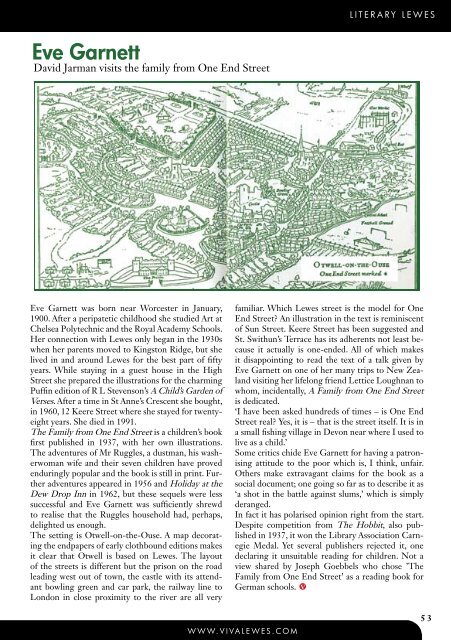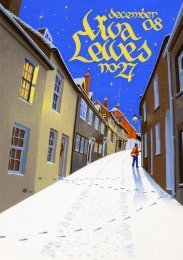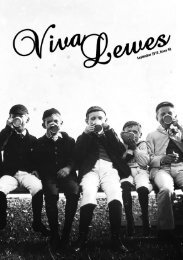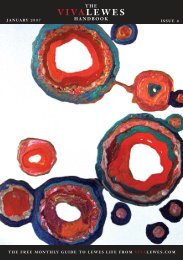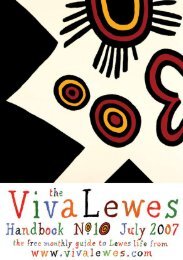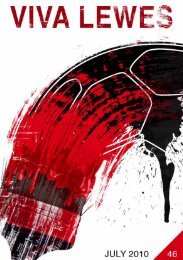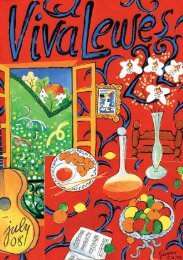You also want an ePaper? Increase the reach of your titles
YUMPU automatically turns print PDFs into web optimized ePapers that Google loves.
Eve Garnett<br />
David Jarman visits the family from One End Street<br />
Eve Garnett was born near Worcester in January,<br />
1900. After a peripatetic childhood she studied Art at<br />
Chelsea Polytechnic and the Royal Academy Schools.<br />
Her connection with <strong>Lewes</strong> only began in the 1930s<br />
when her parents moved to Kingston Ridge, but she<br />
lived in and around <strong>Lewes</strong> for the best part of fifty<br />
years. While staying in a guest house in the High<br />
Street she prepared the illustrations for the charming<br />
Puffin edition of R L Stevenson’s A Child’s Garden of<br />
Verses. After a time in St Anne’s Crescent she bought,<br />
in 1960, 12 Keere Street where she stayed for twentyeight<br />
years. She died in 1991.<br />
The Family from One End Street is a children’s book<br />
first published in 1937, with her own illustrations.<br />
The adventures of Mr Ruggles, a dustman, his washerwoman<br />
wife and their seven children have proved<br />
enduringly popular and the book is still in print. Further<br />
adventures appeared in 1956 and Holiday at the<br />
Dew Drop Inn in 1962, but these sequels were less<br />
successful and Eve Garnett was sufficiently shrewd<br />
to realise that the Ruggles household had, perhaps,<br />
delighted us enough.<br />
The setting is Otwell-on-the-Ouse. A map decorating<br />
the endpapers of early clothbound editions makes<br />
it clear that Otwell is based on <strong>Lewes</strong>. The layout<br />
of the streets is different but the prison on the road<br />
leading west out of town, the castle with its attendant<br />
bowling green and car park, the railway line to<br />
London in close proximity to the river are all very<br />
familiar. Which <strong>Lewes</strong> street is the model for One<br />
End Street? An illustration in the text is reminiscent<br />
of Sun Street. Keere Street has been suggested and<br />
St. Swithun’s Terrace has its adherents not least because<br />
it actually is one-ended. All of which makes<br />
it disappointing to read the text of a talk given by<br />
Eve Garnett on one of her many trips to New Zealand<br />
visiting her lifelong friend Lettice Loughnan to<br />
whom, incidentally, A Family from One End Street<br />
is dedicated.<br />
‘I have been asked hundreds of times – is One End<br />
Street real? Yes, it is – that is the street itself. It is in<br />
a small fishing village in Devon near where I used to<br />
live as a child.’<br />
Some critics chide Eve Garnett for having a patronising<br />
attitude to the poor which is, I think, unfair.<br />
Others make extravagant claims for the book as a<br />
social document; one going so far as to describe it as<br />
‘a shot in the battle against slums,’ which is simply<br />
deranged.<br />
In fact it has polarised opinion right from the start.<br />
Despite competition from The Hobbit, also published<br />
in 1937, it won the Library Association Carnegie<br />
Medal. Yet several publishers rejected it, one<br />
declaring it unsuitable reading for children. Not a<br />
view shared by Joseph Goebbels who chose ’The<br />
Family from One End Street’ as a reading book for<br />
German schools. V<br />
W W W. V I V A L E W E S . C O M<br />
L I t E r A r y L E W E S<br />
5 3


